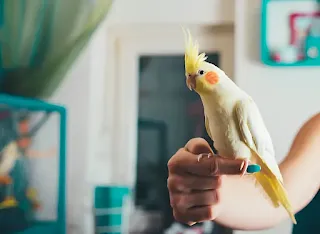How to Prevent Your Exotic Bird from Biting
Exotic birds are known for their intelligence, beauty, and charm, but they also have their moments of aggression. One of the most common behavioral challenges bird owners face is biting. While a bite from a small parakeet might only cause a minor pinch, larger birds like macaws or cockatoos can deliver a painful and even dangerous bite.
Understanding why your bird bites and learning how to prevent it are essential steps in fostering a strong, trusting relationship. In this comprehensive guide, we’ll explore the causes of biting, ways to prevent it, and strategies to ensure a harmonious bond between you and your feathered friend.
Understanding Why Birds Bite
Birds communicate primarily through body language and vocalizations. Biting is not inherently malicious; it’s often a response to their environment or feelings. By understanding the root causes, you can address the issue more effectively.
Common Reasons for Biting
Fear or Stress: Birds may bite when they feel threatened or insecure. New environments, loud noises, or sudden movements can trigger fear responses.
Territorial Behavior: Some birds become protective of their cage, toys, or favorite person and may bite to defend their space.
Hormonal Changes: During breeding season, hormonal surges can lead to aggression, including biting.
Mishandling: Improper handling or approaching a bird without understanding its comfort level can result in bites.
Attention-Seeking: Birds are intelligent creatures that may bite to elicit a reaction from their owners.
By observing your bird’s behavior, you can identify patterns and triggers that lead to biting.
Recognizing Warning Signs
Raised feathers, particularly on the head or neck
Lunging or sudden movements toward you
Dilated pupils or intense staring
Hissing or growling sounds
Body posture changes, such as crouching or leaning forward
If you notice any of these signs, give your bird space and avoid pushing them further into discomfort.
Preventing Biting: Building Trust and Respect
Preventing biting starts with building a foundation of trust and mutual respect. Here are some key strategies:
1. Establish a Routine
Birds thrive on predictability. Establishing a daily routine for feeding, playtime, and rest helps them feel secure and less prone to stress-induced biting.
2. Respect Personal Space
Don’t force interactions, especially when your bird is showing signs of discomfort. Allow your bird to come to you on their terms.
3. Use Positive Reinforcement
Reward good behavior with treats, praise, or gentle petting. Positive reinforcement encourages your bird to associate calm interactions with rewards.
4. Gradual Socialization
Expose your bird to new people, environments, and experiences gradually. Overwhelming them can lead to defensive biting.
5. Proper Handling Techniques
Learn how to handle your bird correctly. Support their body fully and avoid sudden movements that may startle them.
Training Techniques to Discourage Biting
Target Training
Use a stick or pointer to teach your bird to follow a target. This builds trust and reduces the need for direct hand contact, minimizing the risk of bites.
Redirect Aggression
If your bird becomes agitated, redirect their attention to a toy or activity to diffuse tension.
Teach “Step-Up” Command
Train your bird to step onto your hand or perch on command. This establishes control and reduces handling-related biting.
Ignore Negative Behavior
Avoid reacting dramatically to bites. Birds may find reactions rewarding and repeat the behavior.
Creating a Safe Environment
The environment plays a significant role in your bird’s behavior. Ensure their surroundings support calm and positive interactions.
1. Cage Placement
Position the cage in a quiet, low-traffic area to minimize stress.
Ensure your bird has a clear view of their surroundings to feel secure.
2. Toys and Enrichment
Provide a variety of toys to keep your bird mentally stimulated and prevent boredom-related aggression.
Rotate toys regularly to maintain their interest.
3. Proper Diet
A healthy diet contributes to stable mood and behavior. Provide a balanced mix of pellets, fresh fruits, vegetables, and occasional seeds.
Managing Hormonal Biting
Reduce daylight exposure by covering the cage earlier to mimic shorter days.
Limit access to nesting materials or dark, enclosed spaces.
Avoid petting areas that stimulate hormones, such as the back or tail.
Provide distractions, such as foraging toys or new activities.
What to Do After a Bite
If your bird bites, how you react can influence future behavior. Follow these steps:
Stay Calm: Avoid yelling or jerking your hand away, as this can reinforce biting.
Assess the Situation: Identify what triggered the bite and take steps to avoid similar situations in the future.
Redirect Behavior: Offer a toy or command them to step onto a perch to shift their focus.
Rebuild Trust: Spend quality time with your bird using positive reinforcement to restore trust.
Common Myths About Bird Biting
Myth: “Biting is just part of owning a bird.”
Fact: While biting can happen, it’s not inevitable. Proper training and care can minimize biting.
Myth: “Birds bite out of spite.”
Fact: Birds don’t act out of malice. Biting is usually a response to fear, discomfort, or miscommunication.
Myth: “Once a bird bites, it can’t be trusted.”
Fact: Trust can be rebuilt with patience and positive interactions.
Case Studies
A territorial Amazon parrot frequently bit its owner when reaching into the cage. By introducing target training and handling the bird outside the cage, the owner reduced biting incidents significantly.
Case 2: The Fearful Cockatiel
A cockatiel rescued from a stressful environment was prone to biting. Gradual socialization and consistent routines helped the bird become more trusting and less aggressive.
Final Thoughts
Preventing your exotic bird from biting requires understanding, patience, and dedication. By learning to interpret your bird’s body language, addressing environmental factors, and implementing consistent training, you can foster a relationship built on trust and respect. A bite-free bond isn’t just a dream—it’s an achievable goal for any bird owner willing to invest the time and effort. Your feathered friend will thank you with affection, playfulness, and lifelong companionship.







